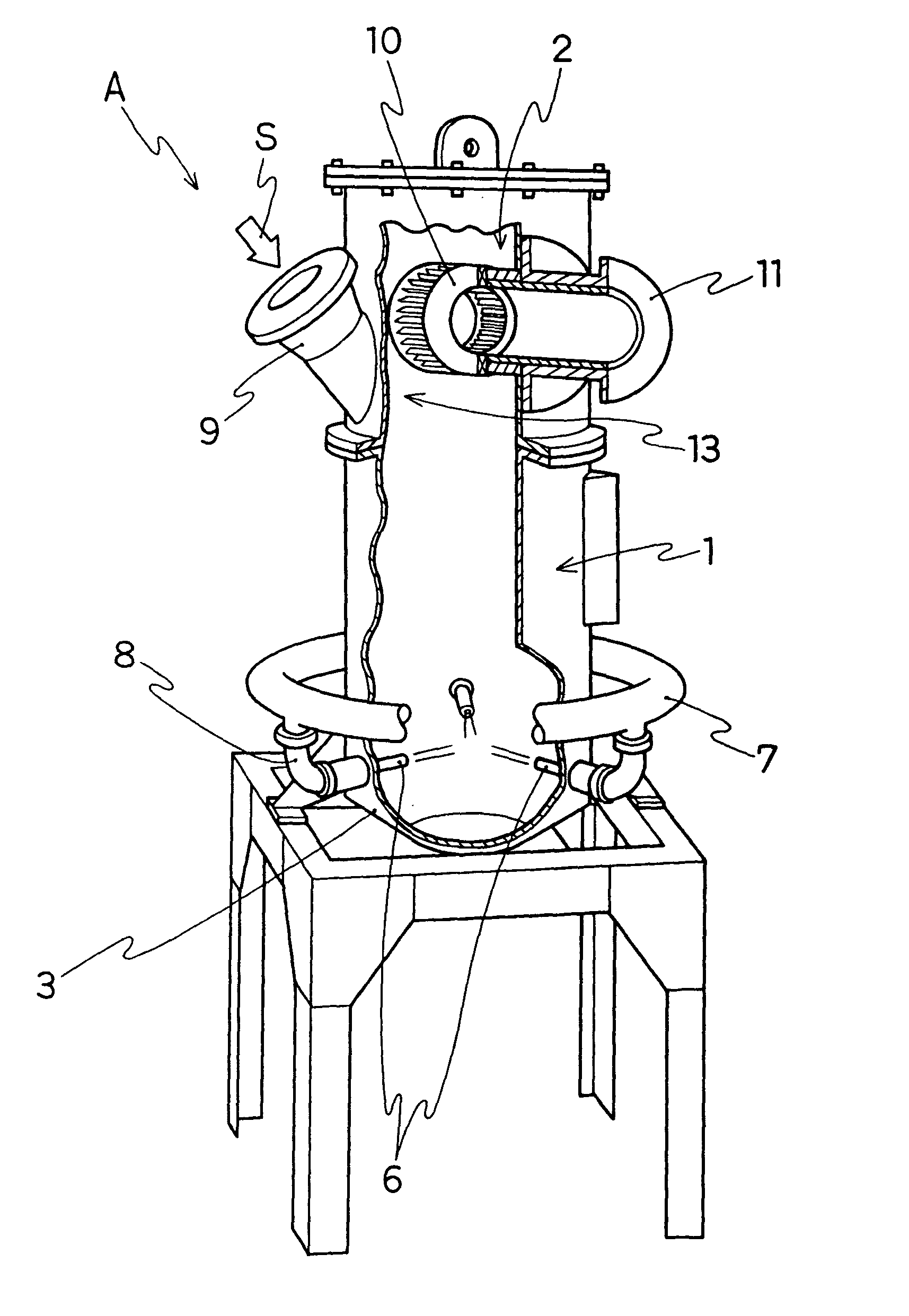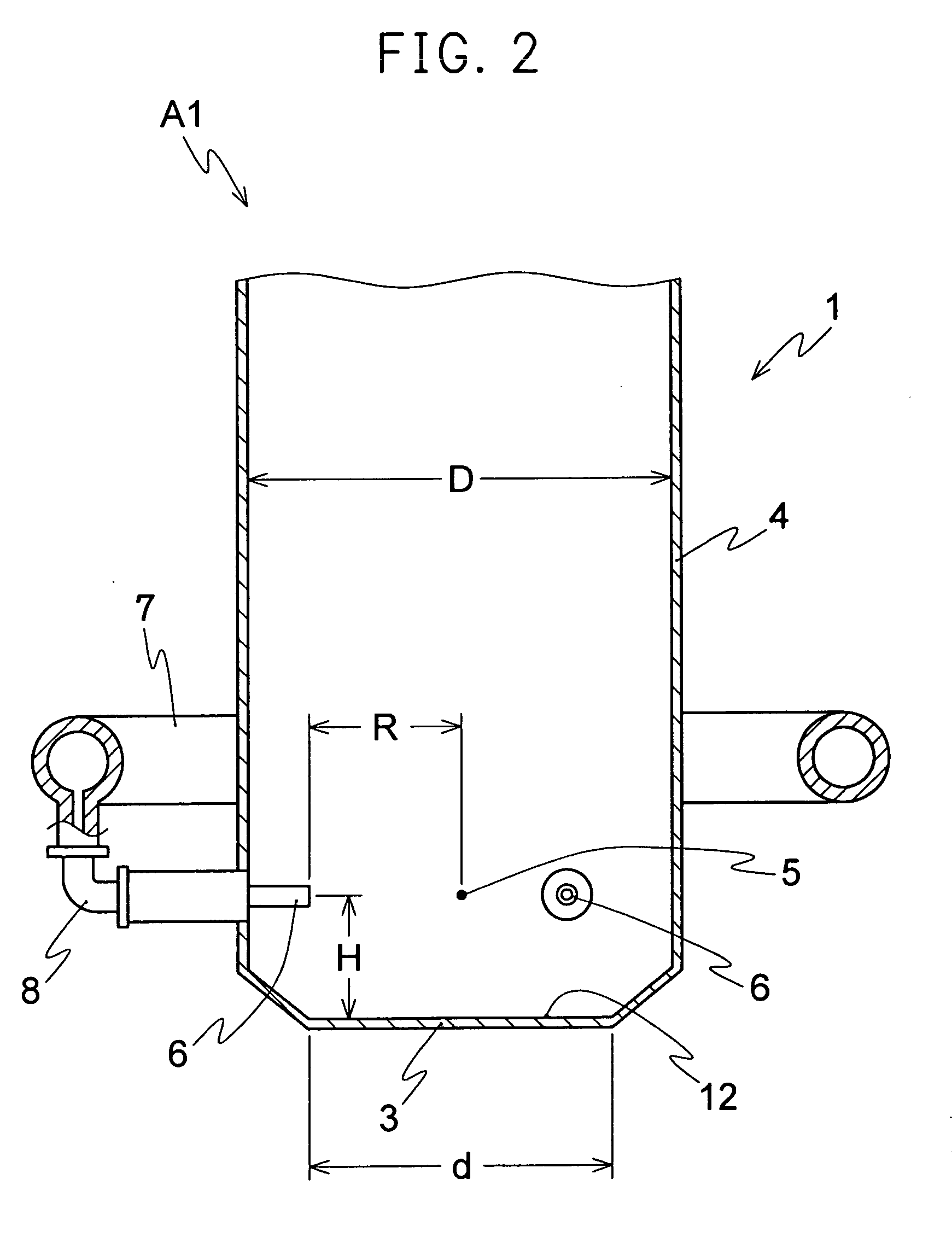Method and device for producing ground resin particles
a technology of ground resin and resin particles, which is applied in the direction of solid separation, grain milling, gas current separation, etc., can solve the problems of reduced grinding ability, reduced apparent density of obtained ground particles, and reduced grinding ability of ground resin particles or non-classified coarse resin particles. excellent
- Summary
- Abstract
- Description
- Claims
- Application Information
AI Technical Summary
Benefits of technology
Problems solved by technology
Method used
Image
Examples
examples 5 to 9
[0094] In order to confirm whether the height of the injection point influences the flowability of the powder, PTFE dried powder (water content: 0.01% by weight) was ground according to the grinding condition shown in Table 3, and the relationship between the nozzle distance of jet nozzles and the height, which influences the grinding ability was examined. The compressed air was cooled to 5.5.degree. C. and supplied to maintain the jet mill to 6.0 to 9.0.degree. C. The rotation number of the classifying rotor for collection was set to 1,200 rpm. The results are shown in Table 4 and FIG. 7.
3TABLE 3 Grinding condition Diameter of barrel (inner diameter) (mm) 440 Air pressure (MPa) 0.9 Supplied amount of material (kg / hr) 350 Average particle diameter of material (.mu.m) 700
[0095]
4 TABLE 4 Height of Ex. 5 Ex. 6 Ex. 7 Ex. 8 Ex. 9 injection point Circle diameter (mm) (mm) 300 350 372 400 400 Grinding ability 90 234.8 295.6 291.6 311.2 --(kg / hr) 58 -- -- -- -- 346.2
[0096] Table 4 and FIG. ...
example 10
[0099] PTFE resin particles (average particle size: 700 .mu.m) after suspension polymerization which were associated with 6% by weight of water (water: PTFE=6:94) were supplied as PTFE resin particles in Example 1, at a speed of 25.5 kg / hr. On the other hand, the compressed air was injected to the mill at 17.5.degree. C. under a pressure of 0.92 MPa. The cooling of the jet mill was not carried out. As a result, the inside temperature of the mill was maintained at 5.7.degree. C.
[0100] The collected ground PTFE powder had an average diameter of 17.9 .mu.m, an apparent density of 0.26 g / cm.sup.3 and a water content of 0.07% by weight. The grinding efficiency was 34.0 kg / hr.
examples 11 to 13
[0101] The grinding of water-containing PTFE powder (water content: 6% by weight) was carried out in the same manner as in Example 10 except that the temperature of the compressed air was changed to 20.9.degree. C. (Example 11), 32.2.degree. C. (Example 12) and 42.0.degree. C. (Example 13). The results are shown in Table 5.
5 TABLE 5 Ex. 10 Ex. 11 Ex. 12 Ex. 13 Temperature of compressed air 17.5 20.9 32.2 42.0 supplied (.degree. C.) Temperature to be maintained 5.7 9.8 17.1 22.7 in jet mill (.degree. C.) Grinding ability (kg / hr) 34.0 34.5 32.0 32.4 Properties of collected ground resin particle Average particle size (.mu.m) 17.9 16.7 17.5 17.8 Apparent density (g / cm.sup.3) 0.26 0.27 0.26 0.27 Water content (% by weight) 0.070 0.073 0.005 0.004
[0102] Table 5 shows that when water is associated with the resin particles to be ground, the temperature inside the jet mill can be remarkably lowered and cooling of the jet mill is not needed. In addition, even if the temperature of the compres...
PUM
 Login to View More
Login to View More Abstract
Description
Claims
Application Information
 Login to View More
Login to View More - R&D
- Intellectual Property
- Life Sciences
- Materials
- Tech Scout
- Unparalleled Data Quality
- Higher Quality Content
- 60% Fewer Hallucinations
Browse by: Latest US Patents, China's latest patents, Technical Efficacy Thesaurus, Application Domain, Technology Topic, Popular Technical Reports.
© 2025 PatSnap. All rights reserved.Legal|Privacy policy|Modern Slavery Act Transparency Statement|Sitemap|About US| Contact US: help@patsnap.com



